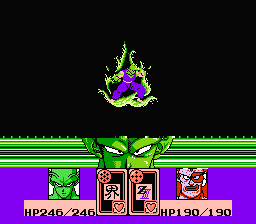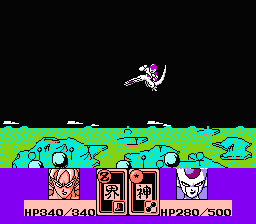Retro Replay Review
Gameplay
Dragon Ball Z III: Ressen Jinzō Ningen continues the card-based RPG tradition of its predecessors, blending strategic deck building with the fast-paced energy of the series’ iconic battles. Each character has a custom set of move cards—ranging from basic strikes to devastating ki blasts—and players must balance offense, defense, and ki management to succeed. As you progress, you’ll acquire new cards and learn more powerful techniques, allowing for deep customization of your three-person active roster.
(HEY YOU!! We hope you enjoy! We try not to run ads. So basically, this is a very expensive hobby running this site. Please consider joining us for updates, forums, and more. Network w/ us to make some cash or friends while retro gaming, and you can win some free retro games for posting. Okay, carry on 👍)
In this game, you control many characters from the animé series, including Son Goku, Son Gohan, Krillin, Piccolo, Yamcha, Trunks, and even the archrival Vegeta, who has now joined the team. In battles, you have three active characters, but you can switch and train them in between. The RPG system is similar to the one used in the first two games: your movements on the field and during battles are determined by the type of cards you choose from several available ones. The cinematic battle sequences are now more fast-paced, and there are many mini-games to speed up the leveling up.
Beyond the standard turn-based encounters, mini-games inject variety into combat. Timing-based QTEs during Super Saiyan transformations and Android hunts reward precision, while training drills let you hone your characters’ stats in unique challenge modes. This structure keeps the pacing brisk, rewarding both strategic thinkers and players who crave dynamic, reflex-driven segments.
Character progression feels satisfying thanks to an intuitive leveling system. Between battles, you allocate experience points to strength, defense, speed, and ki pools. Learning when to specialize a character (for example, boosting Piccolo’s ki for more energy attacks versus buffing Yamcha’s agility for quick strikes) adds a layer of long-term planning that veterans of RPGs will appreciate.
Graphics
On the Super Famicom hardware, Dragon Ball Z III pushes the 16-bit era’s limits with vibrant color palettes and detailed sprites. Backgrounds—from the rocky plains of Namek to the gleaming corridors of Cooler’s ship—are rich in texture, creating an immersive backdrop for each encounter. Even on a CRT display, the game bursts to life with sharp outlines and expressive character poses.
Sprite animations for key techniques—such as the Kamehameha, Special Beam Cannon, and Cooler’s Death Saucer—are fluid and impactful. Quick-cut cinematics bookending major attacks emphasize scale and power, faithfully capturing the Anime’s dramatic flair. Small touches, like Goku’s hair swaying during a Spirit Bomb charge or Vegeta’s smirk before launching an assault, showcase attention to detail that fans will love.
Menus and UI elements blend seamlessly with the on-screen action. Card icons are clearly distinguished by color and symbol, reducing confusion during heated battles. Character portraits that appear during dialogue and event sequences are drawn in an anime-inspired style, lending personality to NPCs and party members alike.
While limited by sprite resolution, the game’s visual direction remains consistently on brand. It faithfully translates Akira Toriyama’s designs into pixel art, retaining the series’ energetic aesthetic without overwhelming the hardware. For an early ’90s JRPG, the graphical presentation holds up surprisingly well today.
Story
“Hot Battle: The Androids” (the game’s unofficial English title) is a direct sequel to the second RPG of the Dragon Ball Z series. Following the events depicted in the manga series those games are based on, “Hot Battle” picks up the story right where it ended in the previous game: in the ultimate battle, Son Goku defeated Frieza, the evil Planet Destroyer. However, Frieza’s brother Cooler swears revenge. Son Goku and his friends have once again to fight the evil in order to keep the miraculous Dragon Balls.
The narrative unfolds across diverse locales—from fortified mountain bases to the heart of Cooler’s stronghold—each stage revealing more about the antagonist’s motives and the heroes’ resolve. Occasional side quests dive into the backstories of lesser-known fighters like Yamcha and Piccolo, enriching the lore with personal stakes and rivalries that deepen as you progress.
Storytelling is delivered through a mix of text boxes, character portraits, and short animated sequences. While the lack of full voiceovers is a product of the era, the dialogue remains punchy and true to each character’s personality. Players familiar with the manga or anime will appreciate subtle nods and Easter eggs woven into event scenes.
The pacing strikes a solid balance between exposition and action. Key plot beats—like Goku’s Super Saiyan upgrades or the reveal of Cooler’s secret transformation—are earned through challenging boss fights and climactic card duels. This structure ensures that the story never stalls, propelling you forward with a blend of narrative intrigue and mechanical rewards.
Overall Experience
Dragon Ball Z III: Ressen Jinzō Ningen successfully refines the formula established by its predecessors, offering a deeper combat system, an engaging story, and eye-catching visuals. The interplay between card selection, character growth, and mini-games creates a gameplay loop that’s both strategic and dynamic, ensuring each play session feels fresh.
For longtime fans of the series, the game delivers fan service in spades—iconic characters, memorable one-liners, and epic boss showdowns that channel the same excitement as the anime. Newcomers to the franchise will find the learning curve approachable, thanks to clear tutorials and gradual difficulty scaling. However, non-Japanese speakers should note that this release lacks an official translation, making knowledge of basic kanji essential for following the plot and menus.
Replay value is strong, with unlockable characters, alternative battle routes, and multiple difficulty settings. Collecting all cards and mastering every mini-game challenge can extend playtime well beyond the 20–30 hours required to see the end credits. Multiplayer options are limited to hotseat-style duels, but even these brief head-to-head clashes can be a blast with friends.
In summary, Dragon Ball Z III: Ressen Jinzō Ningen stands as one of the best Dragon Ball RPGs of the 16-bit era. Its combination of strategic depth, authentic presentation, and faithful storytelling makes it a must-play for DBZ enthusiasts and retro RPG lovers alike. Whether you’re chasing new cards, unlocking secret forms, or simply reliving the cooler arc, this title delivers an experience worthy of the Dragon Ball legacy.
 Retro Replay Retro Replay gaming reviews, news, emulation, geek stuff and more!
Retro Replay Retro Replay gaming reviews, news, emulation, geek stuff and more!









Reviews
There are no reviews yet.